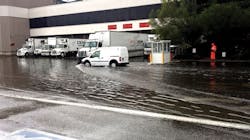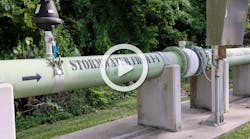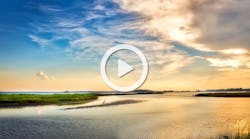About the author: Garth Engelhorn, CPSWQ, is water resources project manager and senior consultant for Alta Environmental. Engelhorn can be reached at [email protected].
The California State Water Resources Control Board adopted a new National Pollutant Discharge Elimination System (NPDES) permit to regulate discharges associated with industrial activities. The new Industrial General Permit 2014-0057-DWQ (IGP) went into effect on July 1, 2015, and includes increased sampling requirements and numerous changes that will increase the likelihood of a Qualifying Storm Event (QSE) falling within normal business hours.
The definition of a QSE has been modified to increase the number of QSEs eligible for sample collection. Under the previous IGP (97-03-DWQ), samples had to be collected within the first hour of discharge, greatly limiting how many storm events could be sampled each year. Under the new IGP, sampling can be conducted within the first four hours of discharge, or at the start of facility operations, if the QSE occurs within the previous 12-hour period. For example, if it starts raining on Sunday night, a discharger may have the opportunity to sample on Monday morning. Furthermore, a QSE is a precipitation event that produces discharge for at least one drainage area preceded by 48 (not the prior 72) consecutive hours without a discharge. And with no minimum rainfall requirement, it is important to understand whether 0.05 or 0.5 in. produces runoff at a facility. The dischargers need to know when it is going to rain, how much it will rain and whether or not it will be enough to create discharge from their facility.
The previous IGP required two QSEs to be sampled during the wet season, defined as October through May. Under the current IGP, the season extends from July through June the following year. Sampling is required during two QSEs between July 1 and Dec. 31, and two QSEs between Jan. 1 and June 30. Whether California experiences continued drought, or El Niño delivers much-needed rain, dischargers need to be informed about the weather year-round. Using online National Weather Service (NWS) tools, dischargers can reduce the uncertainties and effectively target storms for IGP sampling requirements in California.
Watching the Weather
Industrial dischargers do not need to be weather experts, but knowing where to access the best available weather forecasts will greatly increase the odds of being prepared for all QSEs in a given season. Industrial dischargers need to do more than just watch the evening news to predict when it is going to rain and if it will rain enough to result in a QSE. NWS provides many useful tools and online products for planning, mobilizing and executing storm water monitoring events. NWS forecast operations run continuously, 24 hours a day, 365 days a year, providing the public with constant weather monitoring. The most widely used NWS resources by storm water managers throughout the nation include written forecast discussions; digital point forecasts; quantitative precipitation forecasts; radar and satellite imagery; and real-time observations of the weather and rainfall.
For example, the NWS forecast weather table provides a summary of the weather expected for the next seven days, which is available on the home page of each of the six NWS offices in California. With a click on the map, the table provides a point forecast for any location of interest, including two important parameters: the probability of precipitation expressed as a percent of measurable precipitation in six-hour intervals for seven days, and the expected rainfall amounts in six-hour intervals for three days. With these easy-to-use NWS products, industrial dischargers have access to the most updated and accurate forecasts, which provide the information necessary to determine when and how much it will rain at a given location.
Still, in recent years, there have been few storm events and even fewer QSEs that have fallen within business hours. California received only 40% to 75% of average precipitation last season, and the last four consecutive wet seasons were the driest periods on record, with a deficit of 26 in. of precipitation statewide. If the drought continues and a discharger does not have the opportunity to sample all four QSEs, the NWS products are a great resource for documenting rainfall observations to explain why the sampling requirements were not fulfilled.
The latest official forecast from National Oceanic and Atmospheric Administration’s Climate Prediction Center favors a significant Pacific Ocean phenomenon called El Niño to develop during the Northern Hemisphere winter. During El Niño winters, the southern storm track tends to become more active, bringing more rain to the southern U.S. Strong El Niño events tend to be reliably wet for all of California, but weak or moderate- strength El Niños can produce disappointing rain across California.
No matter what this winter brings to California, the extended sampling season and the expanded window for QSEs, and with use of the publicly available NWS tools, dischargers should be able to more effectively target viable storm events. With the current prospects for a wet winter brightening, California’s much-needed El Niño may allow dischargers better opportunities to sample all four QSEs and comply with the new IGP.
Download: Here


